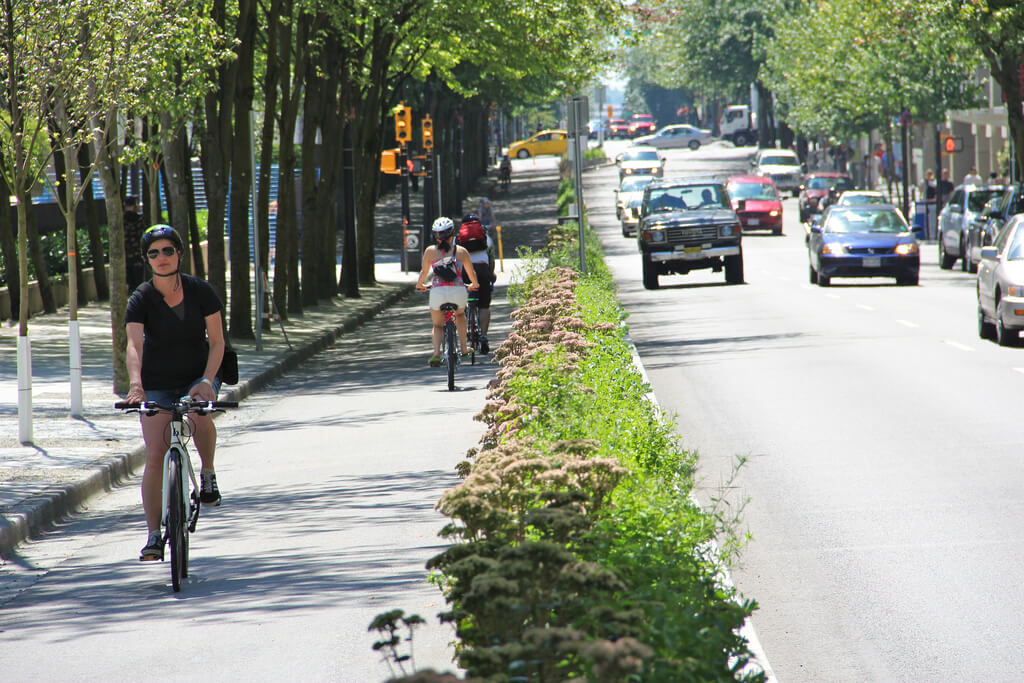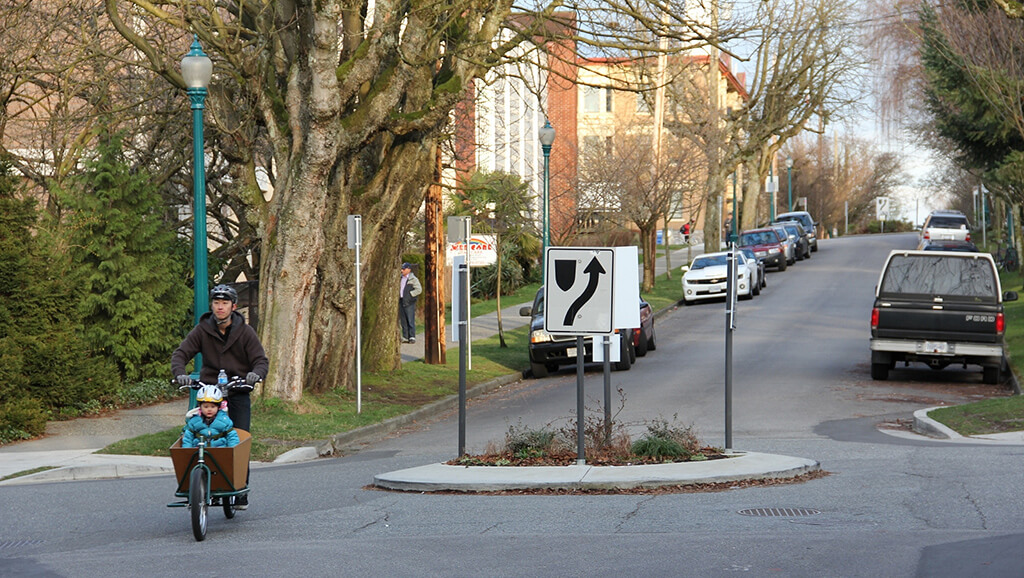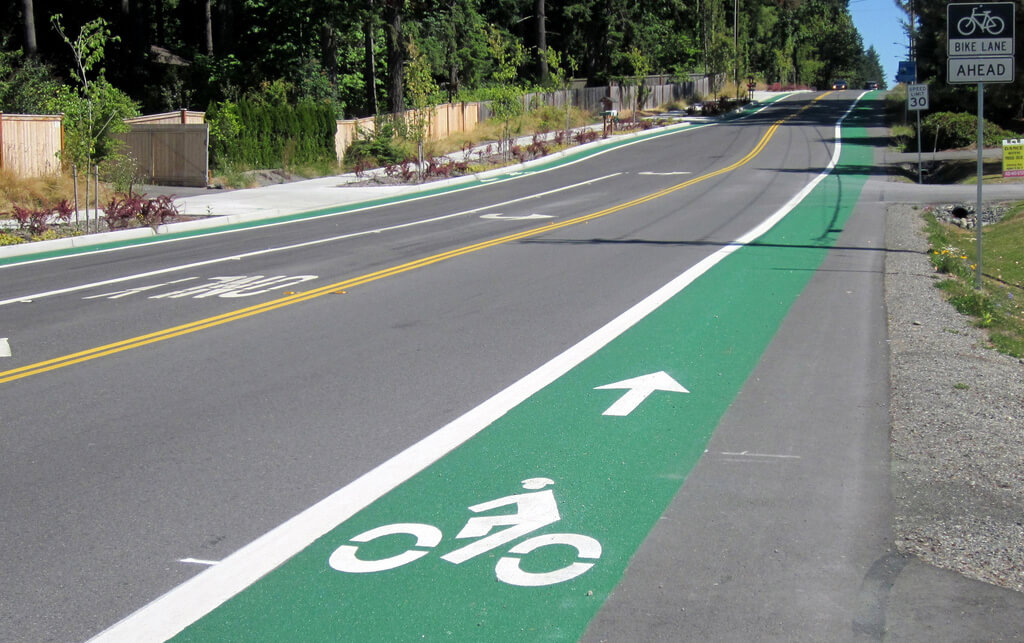Autumn Gear Guide
Find inspiration in our Gear Guide that will keep you out on your bike through wind or rain.
Download NowThis season’s must-haves for commuting around town safely and in style.
There’s a seemingly endless number of products on the market designed to keep urban bicyclists safe. LED-enabled smart helmets, fluorescent jackets with reflective arrows, backpacks that signal turns, rear lights which project bicycles onto the ground behind you, and the list goes on. With such a dizzying array of choices to keep yourself safe on the roads, it can be difficult to decide which types of equipment are the most effective, and where we should be investing our money.
In an effort to clear things up a bit, we’ve rounded up a list of our top 5 cycling safety innovations that no urban cyclist should be without. While I guess it’s not really “gear” so much as “infrastructure,” is now really the right time to nitpick about diction?

A planter-box buffer protects Vancouver’s Hornby Street bike lane from vehicle traffic. Photo by Paul Krueger.
Buffers top the list for urban cycling safety gear because of their proven effectiveness at keeping people on bikes from getting smushed by people driving cars. While painted-on bike lanes are certainly a step in the right direction for cycling safety, they’re only as effective as motorists’ willingness to avoid driving or parking in them. Buffers are the game changer – by physically separating vehicle traffic from bicycle traffic, they can basically eliminate conflicts between the two modes. We decided to give the top spot to buffers rather than the infrastructure they’re commonly associated with (protected bike lanes), because they can also be employed in the less common but equally important protected intersection, and do their life-saving thing all the way through the road network.
While buffers are most commonly seen in the form of bollards or simple concrete barriers, many cities are going the extra mile and building planter-box buffers such as the one above. Both stylish and practical!

Can’t go flying through that intersection anymore. Photo by Paul Krueger.
In a previous era of urban planning it was deemed acceptable to simply decide on a speed limit, post a sign indicating what it is, and hope for the best. When that didn’t work to sufficiently slow traffic, the police began ticketing people who drive above the speed limit. But ticketing is unevenly enforced and, give the extent of the problem, not an effective solution to actually combat speeding. Recent improvements in the approach cities take to reduce vehicle speed have been more effective. Rather than rely on the public’s willingness to drive the speed limit or the cops’ ability (or willingness) to enforce it, many cities have been building physical infrastructure that simply makes it impossible to drive quickly. While most people are familiar with speed bumps, some of the latest and greatest innovations in traffic calming also include roundabouts, curb extensions, bollards, and road narrowing measures.
The infrastructure that reduces vehicle speeds are our second favorite category of cycling safety gear because lowers speeds lessen the chances that motorists will hit a bicyclist by giving them more time to observe and react to other road users. In the unfortunate circumstance that somebody does get hit, lower speeds dramatically reduce the extent of the injuries sustained by the victim upon impact. Let’s hear it for traffic calming infrastructure, every urban cyclist should have some!

Signal phasing comes in fun summery colors like bright yellow and illuminated green. Photo by Paul Krueger
Intersections are unfortunately where the majority of conflicts between bicyclists and motorists take place. Getting right-hooked, or having a motorist make a left turn without yielding to the bicyclist going straight on a green are two very common crash scenarios that never end well for the person riding the bike. For that reason, dedicated traffic signal phasing that provides separate travel times for bicyclists and motorists is third on our list of this season’s hot new trends in cycling safety innovation. Top-of-the-line bicycle signal phases will provide completely separate travel times for the different modes, while the more mid-range models will give bicyclists a slight time advantage to get into the intersection before motorists are allowed to move.

Imagine multiple people trying to use this road without paint. Photo by Gene Bisbee.
Probably the most under-appreciated type of cycling safety gear on the list, paint nonetheless knocks in out of the park in terms of its cost-usefulness ratio. Paint is cheap, it’s simple, it’s modest, it’s barely even thought of as infrastructure. Yet it’s absolutely critical to the safety of urban bicyclists the world over. Paint is responsible for laying the groundwork, literally, for every single bike lane on every city street. When employed lazily, it takes the form of sharrows which are crap but better than nothing I guess maybe. But when employed well, it can be a beautiful bike lane, brightly-colored to remind motorists that they cannot park or drive here. Paint indicates the direction of traffic flow, it identifies problem spots in intersections, it warns of impending dangers or changes in traffic flows, it tells pedestrians where to safely cross. Not only that, paint is available in an almost endless variety of colors, so any city can choose a scheme that suits their personal style, making paint both critical and aesthetically versatile! Win.
No road network is complete without a healthy dose of well-placed signage. Signs help road users navigate their path around the city, indicate speed limits and other laws, remind people to look out for other road users, identify school and playground zones, and do a whole load of other work crucial to the successful operation of an urban traffic system. We love road signage because it reminds people driving to look out for bicyclists, reminds people on bikes to look out for pedestrians, assists in wayfinding, and even warns us when a particularly steep hill is after the horizon so we know not go zooming down it and go flying over our handlebars.
Find inspiration in our Gear Guide that will keep you out on your bike through wind or rain.
Download Now
Thanks for the insightful write up Hilary.
Aside from being aware of the surrounding infrastructures, cyclists also need take the initiative to minimize their risk of collision and never take things for granted, even if they have the right of way. A while ago, I wrote an article listing out the 35 simple steps every cyclists can take to increase their safety.
It focuses on behavior, etiquette and equipments. Have a read at https://www.thegeekycyclist.com/tips/bicycle-safety-tips/
What about education?
Segregated lanes, even those with buffers only appears to be efficient in a few situations, they always fail educating drivers in the rest of situations where a segregated lane can’t be designed/placed (wich is the absolute majority of situations)
Education will work in any situation but this “secure” infrastructure will not.
Not my kind of urban biking sorry, I prefer to go free without being forced to use any supposed “secure” lane made with fears.
Thank you thank you thank you for identifying infrastructure as the most important safety gear! That and more people riding bikes make us all safer.
The one we disagree with is ‘paint’. In no way does ‘paint’ protect cyclist. Just this year in Boulder County, Colorado we have had four cyclists run over by automobiles because there wasn’t a physical buffer to protect them.
That is a fair comment. We agree that protected bike lanes are best. #1 spot goes to buffers!
Email is also important. Write to your councillors, to your Mayor, to your politicians. Tell them you want better cycle infrastructure. Then 3 months later do it again and again and again. They need to hear how vital this is.
Yes! Getting involved by email, snail mail, and showing up for council meetings is vital to making better infrastructure a reality. If one does not contribute to making it happen then who is to blame?
Comments are closed.